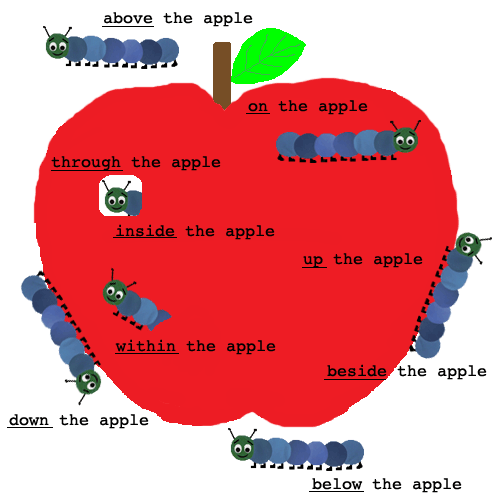26 3.5 Prepositions
Preview
This section of Ch. 3 will cover the following topics:
- the job of prepositions
- using prepositions to avoid common writing problems
The first five parts of speech we studied–nouns, pronouns, verbs, adjectives, and adverbs–are the foundation of a sentence. They tell us who is doing what.
The small dog is barking loudly. It is annoying.
But many sentences are more complex than simply who and what. We also want to know where and when.
The small dog ran into the street. (where)
The dog barks every day at 7 a.m. (when)
What Is a Preposition?
A preposition is a word that shows the position of something or someone in space and time. If you look at the word “preposition,” you’ll see the word “position.” A preposition tells us where and when.
A prepositional phrase is a common component of English sentences. A prepositional phrase is a group of words that begins with a preposition, ends with a noun or pronoun, and does not include the verb or subject.
In the sentences above, “into the street” is a prepositional phrase that shows where the dog ran. “at 7 a.m.” is a prepositional phrase that tells us when it barks. Notice that both begin with prepositions (“into,” “at”) and end with nouns (“street,” “7 a.m.”), and neither includes the subject or verb of the sentence.
Here is another example:
The study rooms (on the first floor) (of the library) are full (in the morning).
Each group of words enclosed in parentheses is a prepositional phrase: they all start with a preposition (“on,” “of,” “in”), end with a noun or pronoun (“floor,” “library,” “morning”), and don’t include the verb (“are”) or subject (“rooms”). The job of these prepositional phrases is to tell you where the study rooms are and when they are full.
Prepositions Show Position in Space
Here are some common prepositions that show positions in space:
| to | across | over | against | with |
| at | through | inside | under | within |
| in | beyond | between | beneath | without |
| on | among | above | around | below |
| by | near | behind | past | from |
Imagine a plane flying across a sky. We can change the plane’s position in space by changing the prepositions: above the clouds, below the clouds, within the clouds, between the clouds, past the clouds, behind the clouds.
Another way to remember prepositions about space is with this graphic. Think of where the caterpillar is in relation to the apple.

Prepositions Show Position in Time
Here is a list of common prepositions that show position in time:
| at | before | since |
| by | past | throughout |
| in | until | from |
| for | during | between |
| after | within | around |
Imagine that plane is about to land. We can change its position in time by changing prepositions: at 3 p.m., after 3 p.m., before 3 p.m., around 3 p.m.
Exceptions: Of, As, Like
The words “of,” “as,” and “like” are also prepositions, but they don’t fit neatly into either the space or time category. However, they are very common. For example:
book of essays, note of apology, type of bicycle, give as an example, testify as an expert, think like a computer, disappear like magic
Just remember them: of, as, and like are prepositions.
Exercise 3.42
Type up the sentences below, adding parentheses before and after any prepositional phrases.
For example: The cell phone rang (in the other room), but John didn’t wake (from his nap).
Remember: Prepositional phrases always begin with a preposition and end with a noun or pronoun. They sometimes include adjectives or adverbs, but they never include verbs or subjects.
- Meera was deeply interested in marine biology.
- I just watched the season finale of my favorite show.
- Jordan won the race, and I am happy for him.
- The lawyer appeared before the court on Monday.
- For the party, Chloe wore a comfortable blue tunic.
Why Bother with Prepositional Phrases?
Locating prepositional phrases will help you find subjects and verbs–especially in a long sentence. For example:
In the rainy season, one of our windows leaked at all four corners.
If we isolate the prepositional phrases from the rest of the sentence, it is easy to find the verb and subject:
(In the rainy season), one (of our windows) leaked (at all four corners).
All we have left are the words “one” and “leaked.” “one” is the pronoun subject and “leaked” is the verb.
Subjects and verbs never appear in prepositional phrases. This can help writers see and correct things like subject/verb agreement problems, sentence fragments, and other common grammatical errors. (More about subjects and verbs in Ch. 4.)
Exercise 3.43
Re-type the sentences you used for Ex. 1 in Ch. 3.1 again.
Identify the parts of speech we’ve already covered by highlighting the words:
- nouns in yellow
- pronouns in orange
- verbs in red
- adjectives in light green
- adverbs in dark green
Now, look for prepositions. Highlight the preposition itself in blue and enclose each prepositional phrase in parentheses.
Takeaways
- Prepositions show the placement in space or time of other elements in a sentence.
- Identifying prepositional phrases can help writers avoid other grammatical errors.
a groups of words that does not include the sentence subject or verb
separate, remove from the context


